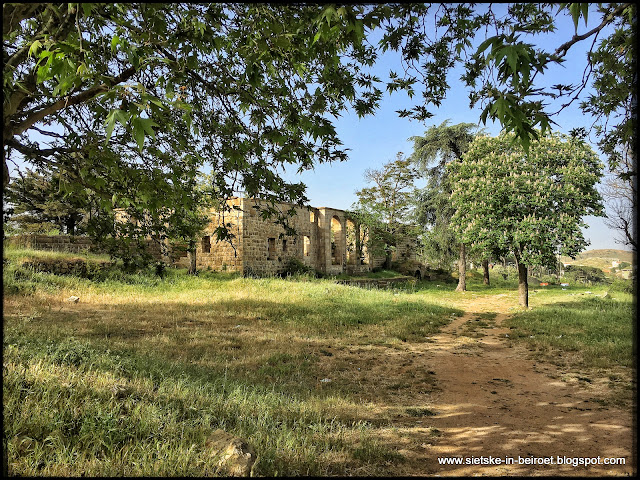The war has ended some 26 years, yet the battle scars are
still visible in many places.
 |
| The railroad tracks are no longer there, but this passage connected Sofar Station to Bhamdoun Station |
Reconstruction has been hampered by a lack of economic
growth, massive corruption, Israeli bombardments, and internal problems between
the political representatives of the different sects caused by their foreign
paymasters. The fact that all the war lords are still running this country,
this time from a seat in the government or the parliament hasn’t helped either,
nor has the looming crisis in Syria.
 |
| Stairs guide you up the hill and past these posts that once must have an iron gate |
Everyone wants/needs to live in Beirut, and as money is poured into real-estate in Beirut, there is none left for development outside. Houses that were abandoned during the war remain uninhabited up till now. Their originals owners must, for the most part, be either very old or dead by now, and those that have inherited either do not have the money to restore or do not see the value of restoration. Or they have left the country long ago, and might not even know that they own property here in Lebanon.
I wonder what the laws are on appropriating property that
has been abandoned for over 50 year and whose owners cannot be located. Might
be an interesting side business; in my years of hiking through towns and
villages, I have seen hundreds of them. They are a popular object for photographers,
not just in Lebanon, but worldwide.
 |
| The hallway |
Some of these monumental houses have been taken over by
Syrian refugees, but that is more of an exception than a rule. The majority
stands empty, some already since 1975, and the looting of fixtures, windows and
stones by occupying armies, militias, or entrepreneurial Lebanese has since
long been completed. What is left is no longer of value.
But the architecture is. Some of these houses are absolutely
fantastic. Roofs are missing, and the interior walls have been stripped to a
bare minimum, but even after so many decades, they still exhales grandeur, and
allude to a once illustrious past.
 |
| The house is so wide, it does not fit in the picture. |
This one property I ran into this morning, is built in the
top part of Bhamdoun, between the old road to the Beqaa valley, and the now
defunct railroad. Bhamdoun became a popular resort once the railroad came
through town, back in the 1890’s. From the former railroad, a steep staircase
goes up the hill, terrace by terrace, until a gate that, judging from the
hinges, must have had a massive iron gate. There are signs that there was once
a fountain in the garden, and water ducts must have watered parts of the
garden.
It is an odd building, since it doesn’t have the usual house
ground plan. The property must have had Jewish occupant, because of the Hebrew
over the door, but since very little is recorded of our history, the cadastral registries
are not public (or maybe even not existent anymore) , and I have no ‘wasta’
at the Bhamdoun municipality, there is no way of figuring out what it once was.
Unless an old inhabitant of the town, or a (Jewish) historian, can fill me in
on this. It looks like it was once a communal building, or it was the house of
someone with either a very large family, or with an eccentric taste. I could
make a beautiful house of it, but alas,
it is not mine.
 |
| The living room? |
And so it lies by the side of the road, forgotten - Its
inhabitants must be dead, and people with memories of the place are no longer
around – until finally it will fall apart, and all that is left is a pile of
rubble. Pity.
And to show you how – despite great advancement in
technology - our collective taste has in fact regressed, I show you a gate from
a property right next to it. What a monstrosity. Now of that would disappear, I don't think anyone would mind.






4 comments:
Bhamdoun does have a synagogue and once had a Jewish population but as the Hebrew on this building is spray-painted, I would imagine it was put there by the Israelis in '82.
Very nice article and photos. Thanks
Informative article and as always, glad to read your stories. Sad that such ugly, pretentious housing styles exist in such beautiful village surroundings. Beirut has long since lost out to oversized towers and ugliness but to see it in the villages is sad indeed.
Great article and photos, thank you
Post a Comment